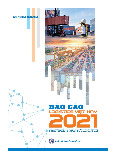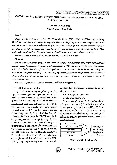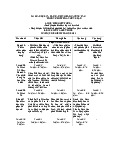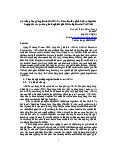







Preview text:
S w 9B05E002
A HACKER ATTACK: AN E-COMMERCE NIGHTMARE (A)
Carlie Bell prepared this case under the supervision of Professor Darren Meister solely to provide material for
class discussion. The authors do not intend to illustrate either effective or ineffective handling of a managerial
situation. The authors may have disguised certain names and other identifying information to protect confidentiality.
Ivey Management Services prohibits any form of reproduction, storage or transmittal without its written
permission. This material is not covered under authorization from CanCopy or any reproduction rights
organization. To order copies or request permission to reproduce materials, contact Ivey Publishing, Ivey
Management Services, c/o Richard Ivey School of Business, The University of Western Ontario, London,
Ontario, Canada, N6A 3K7; phone (519) 661-3208; fax (519) 661-3882; e-mail cases@ivey.uwo.ca.
Copyright © 2005, Ivey Management Services
Version: (A) 2005-02-17
In July 2004, Joseph Roberts, the general manager of BookMart, a major online
book, movie and CD store based out of Toronto, Ontario, Canada, was struggling
to manage a serious breach of the company’s information systems, which
jeopardized both the company’s reputation and its ability to provide service to its
customers. Roberts had to identify how and why this breach occurred, develop an
immediate plan to address the breach both internally and with BookMart’s
customers and the media and develop a plan to ensure the firm minimized its risk
against possible future attacks. E-COMMERCE
Since the mid-1990s when the Internet exploded into the business world,
individuals and businesses have scrambled to access the information
superhighway. In addition to the traditional bricks- and mortar-stores that were
developing websites to attract online shoppers anywhere in the world, numerous
virtual stores had flooded the Internet attempting to offer goods to customers
without the high overhead costs associated with bricks- and mortar-outlets.
In its annual survey of e-commerce, Statistics Canada reported that in the private
sector, the value of online orders rose 28.4 per cent from 2001 to $13.3 billion in
2002. That increase followed an 84 per cent jump in sales in 2001. However,
despite the growth, e-commerce sales accounted for only 0.6 per cent of total Page 2 9B05E002
private sector operating revenue in 2002, up from 0.5 per cent in 2001 and from 0.2 per cent in 1999.1
Statistics Canada reported that, for the second consecutive year, the value of e-
commerce sales was highest in wholesale trade, followed by manufacturing,
transportation and warehousing, and retail trade. These industries accounted for 70
per cent of all Internet sales in 2002.2
Statistics Canada also reported that the 2002 e-commerce market was extremely
volatile, as seven firms stopped selling via the Internet for every 10 that started.
Fierce online competition existed, and the market was made more volatile by
consumers’ lack of trust for online providers. Information confidentiality,
questionable quality and service concerns were only a few of the issues e-
commerce operations had to overcome, and the prediction that “e-commerce will
change the world” had yet to materialize as a result of the lack of consumer confidence.
E-commerce was growing significantly, however. In the United States, the U.S
Department of Commerce reported that e-commerce accounted for only 1.9 per
cent of overall retail spending in May 2004, but online sales grew almost 20 per
cent faster than total sales (total sales growth was 8.8 per cent whereas online sales
growth reached 28.1 per cent).3
As consumers became more familiar with e-commerce transactions, as bandwidth
improvements made product searching and price comparisons faster and more
convenient, and as security and privacy issue were being addressed by both the
private sector and governments, consumer confidence was rising. Numerous e-
commerce sites had become trusted household names (e.g. eBay.com,
Amazon.com, Chapters.Indigo.ca, BarnesandNoble.com, HomeDepot.com).
Finally, mergers and acquisitions (M&As) were common in this competitive e-
commerce environment as firms that discovered a “formula that worked”
attempted to expand their market share by purchasing competitors or joining forces with their supply chains.
1“E-commerce Growing, but Still Tough Business: Statistics Canada,” CBC News, December 4, 2003,
http://www.cbc.ca/stories/2003/04/02/ecommerc_030402, July 22, 2004. 2Ibid.
3“Retail E-Commerce Growth Rate,” Computerworld, June 7, 38(23) p. 48, available at
www.computerworld.com, July 22, 2004. Page 3 9B05E002
THE NETWORK ECONOMY ENVIRONMENT4
After the tragic events in the United States on September 11, 2001, awareness took
on a whole new meaning, both in physical and in electronic form. People became
more conscious that easily obtainable information was due to the global network
economy, and how damaging that information might be in the wrong hands.
Corporations responded by embarking upon new efforts to protect their employees
and customers within a potentially dangerous network environment.
Apart from insider tampering, one of the biggest threats the network economy
faced was “hackers,” people who unlawfully and without permission gained access
to corporate information systems via the information highway and the computer
networks upon which the Internet is based. Hackers (also known as crackers) were
divided into two groups. Hackers usually broke into sensitive corporate systems
and their “claim to fame” was to either publish their “discovery” and the “how to”
instructions on the web or to utilize their “discovery” to blackmail the firm by
demanding ransom be paid in exchange for either not publishing or damaging the
information. On the other hand, “script-kiddies” were the “wannabe hackers” who
utilized the hackers’ published information to break into and damage corporate
systems or reputations. Script-kiddies, however, seldom understood the impact of
their “games,” and their favorite pastime was to deface corporate websites.
These corporate intrusions, or security breaches, could be either blatantly obvious
or virtually invisible, and one of the biggest challenges faced by firms was to be
able to sift through the volume of alerts to determine which were malicious and
which were simply “noise.” In addition to monitoring the volumes and patterns of
data flow via expert systems, firms today relied upon their software vendors to
inform them of alerts or patches to update their systems. Additionally, more and
more firms were hiring external security testing agencies to identify weaknesses in
their systems by performing security reviews, in which the consulting firm played
the role of the hacker and attempted to break into corporate systems.
If a security breach was discovered, often the only way to identify the individual
responsible was to have an informant in the vast “hacker underground.” Some
research houses and consulting firms had these networks, and could be hired to
work with the damaged company and law enforcement authorities to identify the
individual(s) responsible. Unfortunately, Latin America had been identified as the
current “hot spot” for the hacker underground, which made it difficult for North
American firms to prosecute the offenders.
These network attacks, in addition to causing system turmoil that resulted in
damaged reputations and customer service interruptions, were costly. According to
4“Deloitte & Touche defines the Network Economy as the business environment created by massive
global communications interconnectivity and the resulting interdependent business relationships,”
Information Security as a Business Enabler, a Deloitte & Touche brochure, Check Pont Software
Technolgies Ltd., Toronto, 2003. Page 4 9B05E002
the 2003 Computer Security Institute (CSI) and Federal Bureau of Investigation
(FBI) Computer Crime and Security Survey5 (a survey of 503 computer security
practitioners in U.S. corporations, government agencies, financial institutions,
medical institutions and universities), the annual financial losses due to
unauthorized computer use totaled more than $200 million, a figure in line with
prior findings. Of this $200 million, theft of proprietary information was reported
as costing more than $70 million and caused the greatest financial loss. Denial of
service crimes was reported to have cost companies more than $65.6 million, and
financial fraud cost these firms approximately $10.1 million. The most cited forms
of attack or abuse were virus incidents and insider abuse of networks, but of those
companies who reported suffering incidents, only 30 per cent reported those incidents to law enforcement.
As a result of the cost, damage and security threats associated with the network
economy, governments were beginning to legislate the protection of information
and data confidentiality. In Ontario, effective January 1, 2004, the province began
enforcing the federal “Personal Information Protection and Electronic Documents
Act” (Bill C-6), which was an effort to force companies to comply with security
practices, policies and procedures that ensure confidentiality, availability and
integrity of information. However, there was currently no financial penalty for
non-compliance, and as corporations continued to balance the costs, risks, business
productivity, and application development and integration issues, the effectiveness
of this legislation remained to be seen. Additionally, three provinces created their
own legislation and would enforce their own regulations as a result.
However, on an international note, in December 2000, the International
Organization for Standardization (ISO) officially recognized ISO 17799 as the
standard, internationally recognized, comprehensive framework for developing an
effective information security management program. ISO 17799 was becoming the
de facto information security standard, and it was a comprehensive set of best
practices for information security intended to provide a common basis for
developing organizational standards and effective management practices. Earning
ISO 17799 certification was quickly becoming an important reliability and
credibility concern for international organizations, but attaining the certificate was
proving cumbersome as ISO 17799 required that organizations develop not only
enterprise-wide technical and process considerations, but also human
considerations and executive-level commitment.
Corporations worldwide also responded to the infamous Enron scandal in
December 2001, which led to the discovery of numerous corporate greed and
corruption scandals around the world. As a result, management accountability had
taken on new meaning in the corporate domain. Corporate morality and integrity
5An annual survey conducted and published by the Computer Security Institute, available at
www.gocsi.com, accessed July 22, 2004.. Page 5 9B05E002
were now under public scrutiny, and businesses across North America were faced
with the challenge of responding to a much more skeptical marketplace.
Finally, the “Trojan Horse” and “Blaster Worm” viruses that paralyzed industry in
2002 reinforced peoples’ sense of vulnerability, and corporations, as well as the
general public, demanded greater technological security from their information
technology (IT) departments and IT service providers. The blackout in the summer
of 2003 across most of the Eastern United States and Eastern Canada did little to
overcome this sense of vulnerability and dependency on modern technologies,
especially as, in the initial days of the investigation, rumors about terrorists gaining
access to the U.S. electrical grid and/or a technological virus abounded.
Businesses internationally were directly impacted by all of these events, as
technological innovation, globalization, complex and rapidly changing regulations,
and increased senior management and boards of directors’ accountability
combined to alter the risk-management landscape. Additionally, customer
skepticism reached an all-time high, causing increased e-commerce competition
based on price, quality, service and reputation wars.
To protect themselves against possible security attacks and to meet the demands of
the altered global environment, e-commerce firms responded with stricter and
more publicized security measures. Intrusion detection systems, strict password
and personal identification number (PIN) log-on requirements, and access control
software to ensure customers had access only to the public network and not to the
internal private network (which supports internal business environment activities)
or the semi-private network (which enables customer service agents to enter the
public server from the private server in order to assist customers with
technological and order issues) were implemented and publicized, and e-commerce growth continued. IT AT BOOKMART
Like many of the large retail e-commerce sites, BookMart had achieved growth in
part through numerous mergers and acquisitions (M&As) with small and medium-
sized book, CD and video virtual sites. Most recently, in October 2003, BookMart
had merged with a medium-sized virtual music site and had acquired an up-and-
coming online sport video operation. BookMart had earned its online reputation
not only through the quality of its products and service, but also due to the loyalty
program it had initiated and maintained. As customers purchased books, videos or
CDs, points were awarded, which could then be redeemed for discounts on future
purchases. The recent merger and acquisition were particularly enticing for
BookMart as both firms had their own loyalty programs, similar to BookMart’s.
However, the merger of the loyalty programs required special attention so that
customers could retain and utilize points previously earned, despite the conversion Page 6 9B05E002
required to ensure the points allocated were consistent with BookMart’s own generous formula.
Lois Fairchild, BookMart’s Chief Information Officer (CIO), and her IT team were
responsible for integrating the variety of IT equipment and platforms that resulted
from the numerous M&As by their respected deadlines, maintaining the point-of-
purchase (POP) systems, designing the corporate and catalogue web pages
(including the BookMart home page, online technical support pages, customer
order pages and BookMart’s own site search engine), enabling the storage,
delivery and retrieval of e-mail for their employees and the delivery of e-mail to
their customers, as well as developing BookMart’s in-house IT systems (i.e.
maintaining the systems and providing end-user training and support to
BookMart’s employees, including those who responded to the 24-hour customer
support telephone lines). Overall, Fairchild was responsible for overseeing 72 IT
personnel, who were divided into four teams: web development, internal customer
support, external customer support and internal maintenance.
Fairchild was very conscious of the numerous privacy and security measures
necessary for online operations, and she and her IT team had implemented many
security measures to protect the firm. Both BookMart’s employees and their
customers ultimately had access to the same connected system (due to the semi-
private network that connected the private network to the public one), but
employees’ and customers’ access to certain system components, as well as the
resulting security/privacy and the IT department’s ability to influence and control
those measures, were different. As a result, in addition to the access controls in
place, Fairchild had assigned security measures to the internal IT maintenance team.
In addition to constantly patching and updating their virus scanners, firewalls
(intrusion detection systems) and software programs as soon as the vendors made
the IT team aware of new releases or alerts, BookMart’s internal IT maintenance
team took measures that were standard in the industry. Each employee had a
unique user name and password to log into and out of BookMart’s systems.
Emphasis during training (by the internal customer support team) ensured
employees were careful to guard this personal and private information, and
employees were also encouraged to change their passwords regularly. Although
Fairchild’s training team had explained the need to ensure passwords weren’t
easily identifiable (using dates of birth or family names is predictable, and
common words might be picked up by hacker software that uses the dictionary to
identify passwords), it was difficult to ensure that employees carefully selected,
routinely changed and remembered, their passwords.
For months, the IT team had been considering assigning randomly generated
passwords, but discussions with employees resulted in very negative reactions to
this proposal. The biggest concern appeared to be that employees feared their Page 7 9B05E002
inability to remember the assigned, ambiguous passwords, and given that the IT
department had proposed that passwords be changed quarterly, employees feared
that their work would be disrupted due to the complexity (and therefore lack of
memorability) of the ambiguous passwords. Additionally, the internal IT customer
support team was already overwhelmed with meeting their users’ needs, and felt
they were unable to respond to the increase in assistance that would be required if users forgot their password.
External customers were assigned ambiguous user names and passwords by the
external IT customer support team and were reminded through monthly e-mails to
keep that information private and secure. Customer credit card transactions were
secured using Secure Socket Layers (SSL) encryption technology, which
prevented information from being intercepted and read as it was sent over the
Internet to BookMart’s own servers. The external customer support team was
trained by the internal IT customer support team to be extremely cautious when
utilizing the semi-private network to assist customers with orders or technological
issues, especially with regard to user names and password communications.
According to Fairchild, BookMart’s systems were well secured, and the security
and privacy policies in place were more thorough than the industry standard. THE DILEMMA
At 10 a.m., on Friday, July 9, 2004, Roberts was in the middle of discussing
BookMart’s preliminary financial forecasts for the upcoming 2005 fiscal year with
Tim Wilson, the vice-president (VP) of finance of BookMart, when they were
abruptly interrupted. Lois Fairchild rapped on the door and rushed into the room.
Her face was flushed, and she appeared panic-stricken. Fairchild reported that one
of BookMart’s customers had just telephoned BookMart’s support line to inquire
why BookMart’s home page seemed to be displaying a list of peoples’ names and
their contact and billing information on his computer. Fairchild proclaimed that
she was forced to shut down the entire network system until it was secured.
Fairchild explained that a hacker must have broken into the network, most likely
due to a weakness in BookMart’s multi-platform architecture, but what exact
damage the hacker had caused would take weeks, maybe months or even years to
discover. Fairchild knew that the hacker had broken into BookMart’s semi-private
network and had managed to make BookMart’s customer information, internal
human resources data and the firm’s accounting records visible to anyone on the
web who found BookMart’s home page. Until they were able to ensure the privacy
of this information, Fairchild had no choice but to shut down information systems
(IS) to protect customers’ private information (including credit card and bank
account information) and the company’s assets and employee information (social
insurance numbers, salary information, and the company’s own banking Page 8 9B05E002
statements and account numbers, as well detailed accounting records).
Unfortunately, it was difficult to tell if the hacker had tampered with any of
BookMart’s other files or systems in the process, and discovering the hacker’s
exact path through the system was almost impossible. As a result, if the hacker had
altered or damaged any of BookMart’s files, it may only become evident as time
progressed and errors were discovered and reported.
Roberts and Wilson, recognizing the seriousness of this problem, demanded more
information. How was this possible? What damage did the hacker do? How should
BookMart protect itself against possible future attacks? How long must the system
be shut down? What should BookMart tell its customers? Fairchild didn’t have all
the answers yet, nor was she entirely certain about what to do — she was certain the systems were secure!
As Roberts and Wilson listened to Fairchild, it became obvious that BookMart
might be in serious trouble, legally, financially and reputationally. As Fairchild
rushed out of the office mumbling something about “how on earth could this
happen,” the telephone rang. Roberts looked at Wilson hesitantly as he answered.
It was a reporter from Canada’s leading business newspaper, the Globe and Mail,
calling to confirm that BookMart’s systems had been attacked. Roberts opened his mouth and began to speak.




